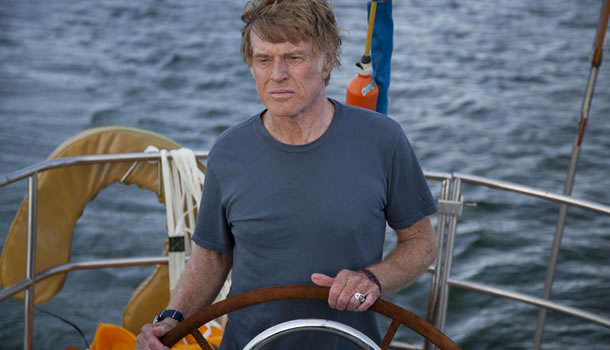The breadth of the ocean, the shortness of life.
J. C. Chandor’s first film, Margin Call, was a surprise hit on VOD and earned the writer-director a Best Screenplay Oscar nomination; it was urban, urbane, concentrated within one night in one place and consisted, mostly, of talk between financial titans and the fall guys they were going to let take the blame. With his follow-up, it’s hard for anyone to accuse Chandor of letting his groove turn into a rut; All is Lost focuses on one person, plays out almost wordlessly and isn’t bound to anything as complex as the machinations of finance. Instead, a man (Robert Redford) wakes on his sailboat in the Indian ocean to find that as he slept, his ship struck a bobbing lost shipping container .. which made a small hole in the side of the sailboat. Of course, there’s no such thing as a ‘small’ hole in a sailboat — and while Redford’s solitary voyager clearly has the skills required in the circumstance, the circumstances soon go far beyond his control.
Many things separate good movies from bad ones, but the one specific thing that separates great movies from good ones is a simple qustion: Does this story exist in a way that cinema is the only way it can be told this well? A movie is not short TV, or radio with pictures, or a comic book that moves or a novel with faces; at its best, it’s a thing unto itself. And so it is with All is Lost, as Redford’s tested-and-partially ready captain deals with catastrophe methodically and intelligently, until methods and intelligence can’t help him. He doesn’t talk to himself because he doesn’t need to. And the way his situation goes from bad to better to bad again and then worse is conveyed not through dialogue or voice-over but instead through pure, visual storytelling.
It’s being suggested that All is Lost is Redford’s best performance — a reminder that in some shady halls of film coverage, ‘best’ is just a lazy synonym for ‘most recent.’ Redford has always been a better actor than we think, with his handsome features and easy charm rolling over his castmates and then us in the audience. But Chandor managed to pick Redford perfectly — it’s hard to imagine this film having the resonance it does if a callow-unmarred 20-something were at the helm of the ship literally and figuratively — and then, even better, gave him something to do other than look great and speak warmly. It’s a performance where the intellectual is expressed through the physical — and where the physical is sorely tested and tried by the sea.
Survival narratives always appeal — the universal fear of mortality; the threat of nature, red in tooth and claw striking back once we’re out of our cities and four-walled homes. All is Lost plays in that primal key, as risk spirals upon risk and giant waves turn into crashing titans. Chandor’s cinematographers Peter Zuccarini and Frank G. DeMarco work with both economy and brilliance, making the 37-foot vessel a world unto itself. Anyone trying to hastily array meaning around some of the film’s visuals — sneakers tumble out of a broken-open container, a giant ark of industry passes as our hero shouts fruitlessly, a lone man in the face of global capitalism — is, frankly, failing to see the sparse trees for a forest they’ve invented. These moments are as simple and believable, and as simply beautiful, as the scenes conveying the sense of long days spent in brutal sun, or the shot that elegantly revels in the gliding presence of hungry creatures in the deep.
All is Lost superbly uses its space and light and score (by Alex Ebert) and every possible technical trick to convey the plight of the sailor we’re watching. Considering that the last story of survival at sea like this required a huge CGI 3D tiger and allegory apparently purchased in bulk, the (relative) simplicity here — sun and sea and night, a universe of wood, wind and wave — takes on real power. It would be one thing if All is Lost merely pulled you in with a firm grip and true skill; what’s even more impressive is what it says to you once it has you in its grasp.

